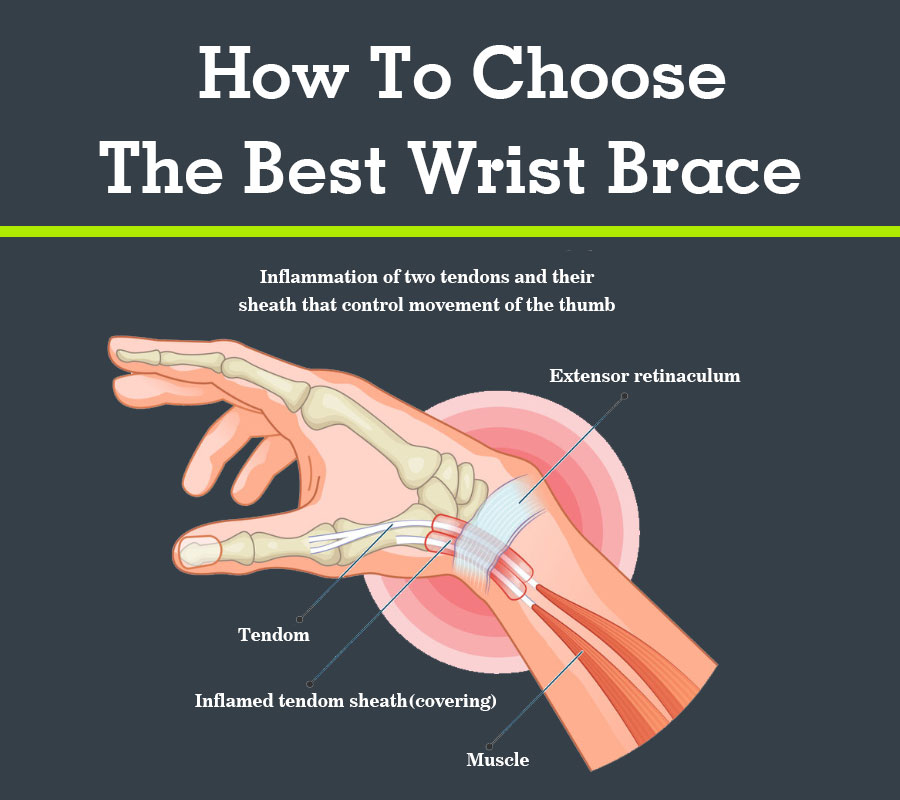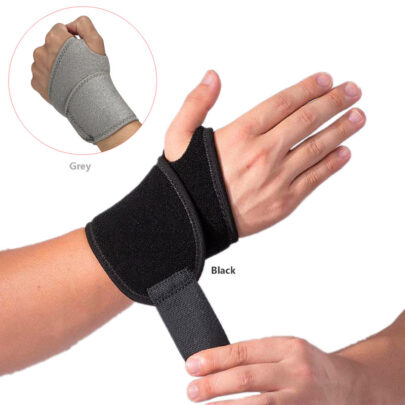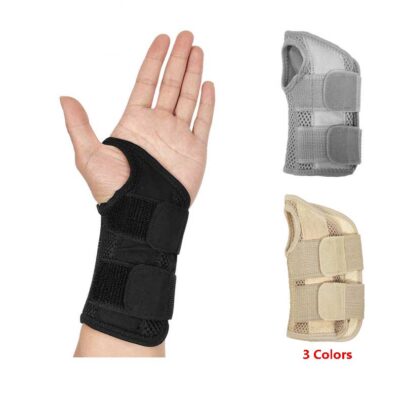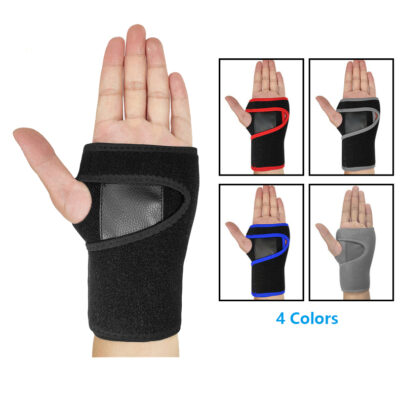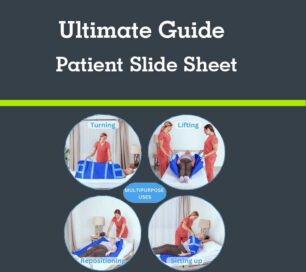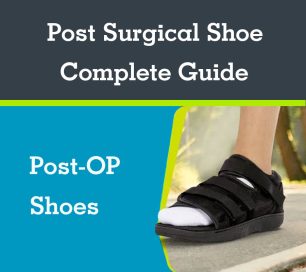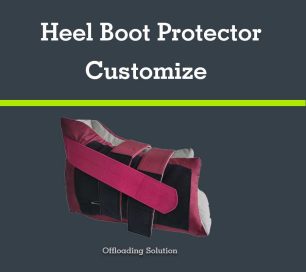Last Updated on 4 years ago by admin
For those with carpal tunnel syndrome, a wrist brace can be a useful tool in reducing pain and managing symptoms.
What is Carpal Tunnel Syndrome?
Carpal tunnel syndrome, also called median nerve compression, is a condition that causes numbness, tingling, or weakness in your hand.
It happens because of pressure on your median nerve, which runs the length of your arm, goes through a passage in your wrist called the carpal tunnel, and ends in your hand. The median controls the movement and feeling of your thumb and the movement of all your fingers except your pinky.
According to the Centers for Disease Control and Prevention (CDC), 1.9 million Trusted Source people in the United States may have carpal tunnel syndrome.
Carpal Tunnel Syndrome Symptoms
- Burning, tingling, or itching numbness in your palm and thumb or your index and middle fingers
- Weakness in your hand and trouble holding things
- Shock-like feelings that move into your fingers
- Tingling that moves up into your arm
Carpal Tunnel Syndrome Causes
- Repetitive motions, like typing, or any wrist movements that you do over and over. This is especially true of things you do when your hands are lower than your wrists.
- Conditions like hypothyroidism, obesity, rheumatoid arthritis, and diabetes
- Pregnancy
Carpal Tunnel Syndrome Risk Factors
- Are a woman. Women are three times more likely than men to get it. This might be because they tend to have smaller carpal tunnels.
- Have a family member with small carpal tunnels
- Have a job in which you make the same motions with your arm, hand, or wrist over and over, such as an assembly line worker, sewer or knitter, baker, cashier, hairstylist, or musician
- Fracture or dislocate your wrist
Carpal Tunnel Syndrome Diagnosis and Tests
- Imaging tests. X-rays, ultrasounds, or MRI exams can let your doctor look at your bones and tissues.
- Electromyogram. Your doctor puts a thin electrode into a muscle to measure its electrical activity.
- Nerve conduction studies. Your doctor tapes electrodes to your skin to measure the signals in the nerves of your hand and arm.
- Tendonitis
- Thoracic Outlet Syndrome
- Fibromyalgia
- Lupus
- Radiculopathy
Carpal Tunnel Syndrome Treatment
- Lifestyle changes. If repetitive motion is causing your symptoms, take breaks more often or do a bit less of the activity that’s causing you pain.
- Exercises. Stretching or strengthening moves can make you feel better. Nerve gliding exercises can help the nerve move better within your carpal tunnel.
- Immobilization. Your doctor may tell you to wear a splint to keep your wrist from moving and to lessen pressure on your nerves. You may wear one at night to help get rid of that numbness or tingling feeling. This can help you sleep better and rest your median nerve.
- Medication. Your doctor may give you anti-inflammatory drugs or steroid shots to curb swelling.
- Surgery. If none of those treatments works, you might have an operation called carpal tunnel release that increases the size of the tunnel and eases the pressure on your nerve.
Do I Need a Brace for My Carpal Tunnel Syndrome?
Most people bend their wrists when they sleep. That puts pressure on the median nerve. A brace can help because it keeps your wrist in a straight, neutral position. A 2012 study found that using a wrist brace at night did more to relieve carpal tunnel symptoms than using no treatment at all.
You may also find it helpful to wear a brace during the day, especially during activities that trigger flare-ups. Repeated motions or extra strain on your wrist can make your symptoms worse. If your job allows for it, try wearing a brace at work.
After you take it off, be sure to keep moving your wrist as you normally would. This helps keep your muscles loose and strong. Just try to avoid too much stress or force on your wrist.
Where Can I Get One?
You can find a wrist brace, which is sometimes called a splint, in most drug stores. Or an occupational therapist can make one for you. When you put on the brace, you’ll want it to be snug, but not too tight. You want to make sure you don’t put even more pressure on your carpal tunnel.
How to Choose a Wrist Brace for Carpal Tunnel
Did you know wearing the wrong wrist brace for carpal tunnel syndrome can be harmful? And if you purchased one from a pharmacy like CVS, Walgreens, or Walmart (costing less than $30) then chances are you purchased the wrong wrist brace.
The manufacturers who make these braces usually sell one or two variations of a brace design. And they claim each brace is appropriate for just about any musculoskeletal condition – including carpal tunnel.
if you want to custom design Wrist brace,please contact us.
In fact, those braces usually have packaging that says “for carpal tunnel syndrome, arthritis, sprains, etc.” But this isn’t true…. and it can’t be true!
Why? Carpal tunnel syndrome is a very different disorder from arthritis or sprains. So it must also be treated very differently.
Simply put, a wrist brace for carpal tunnel is not the same as a wrist brace for any other condition, like a sprain. That’s because treating carpal tunnel syndrome has its own unique issues to consider.
A wrist brace for carpal tunnel is one of the best ways you can treat this disorder. But wearing the correct brace at the proper time is crucial. Not doing so can be harmful, and actually make your symptoms worse.
First, do you have symptoms of carpal tunnel
Before you spend money on a brace for carpal tunnel syndrome, make sure you have this condition to begin with. Carpal tunnel syndrome can mimic many other disorders. Chief among them are:
- Tendonitis
- Thoracic Outlet Syndrome
- Fibromyalgia
- Lupus
- Radiculopathy
In fact, these other disorders even fool doctors. And it’s the main reason carpal tunnel is misdiagnosed over 50% of the time. And that means over 50% of patients have unnecessary carpal tunnel surgery.
Therefore, a proper diagnosis of carpal tunnel syndrome is key. You an start your diagnosis by using these self-tests. They are the same tests doctors use in their office to determine if you have carpal tunnel syndrome versus another disorder.
The hallmark symptoms of carpal tunnel syndrome are numbness, pain or tingling (“pins & needles”) in your palm or fingers. Other symptoms include burning, itching, feeling of puffiness in the fingers, clumsiness, loss of grip strength, and shooting electric shocks when grasping objects.
In its initial stage, these symptoms usually only appear when your hand is at rest. Its why most patients have to wake up at night to rub out the pain or shake out the numbness.
Night bracing alone is usually effective to reverse symptoms – but only in the initial stage.
As the condition worsens, so the do the symptoms. In the severe stage of carpal tunnel syndrome, pain and numbness are intense. And they are present during the daytime. The loss of grip strength and finger dexterity becomes catastrophic.
Most patients also lose the ability to sense hot or cold at their fingertips. Treatment options are few. Night bracing alone is not sufficient to reverse symptoms at this stage. Additional treatments are required.
Finally, end stage carpal tunnel syndrome is when the condition becomes irreversible. No treatment will help, not even carpal tunnel surgery. The hand becomes relatively useless. It forms a “claw hand” due to loss of nerve input. Virtually all feelings in the fingers are gone. Luckily, pain diminishes (because the nerve has died). But numbness is still crushing and punishing.
How to wear a wrist brace for carpal tunnel?
How long should i wear a wrist brace for carpal tunnel
Did not ask these questions:
- Should I wear a brace all the time for carpal tunnel?
- How long should I keep a wrist brace on?
- How many hours a day should I wear a wrist brace?
- Should I wear my wrist brace at night?
Remember these 3 rules for wearing a wrist brace for carpal tunnel syndrome:
- Only wear a certified carpal tunnel wrist brace
- Wear that certified wrist brace only at night
- Never wear any brace during the daytime
Which wrist brace is best?
Only a certified wrist brace for carpal tunnel will help.
Select high quality Wrist Brace products in best price from certified METACARE Sport Support manufacturer in china
Why a certified wrist brace is important?
A certified wrist brace for carpal tunnel syndrome is designed to treat this condition only. It is not designed for treating arthritis, sprains, bursitis, fractures, etc.
The key design feature of a certified wrist brace for carpal tunnel is that is keeps the hand immobile without a palmar spine. This is the metal spine on the palm side of the brace. If your brace has a palmar spine, then it’s not a certified wrist brace for carpal tunnel syndrome.
Why is that important? Carpal tunnel syndrome occurs because of pressure on your median nerve deep inside your wrist joint. Any added pressure on the nerve causes worse symptoms.
A palmar spine on the palm surface of the wrist joint pushes into this soft area of the wrist. This is especially amplified when you bend you hand backward unconsciously while you sleep.
A spine in this soft area will push into the joint, increasing pressure on the median nerve. The pressure further damages the median nerve, making symptoms much worse.
Features of a certified brace:
- The spine on the brace is not located on the palmar surface.
- The brace maintains your hand in a neutral (straight) position.
- Wearing the brace should be comfortable because you must sleep with it.
- The brace should not be tight; this will restrict fluid drainage and blood circulation.
- Make sure the wrist brace is easily put on and removed; Velcro straps are the most useful.
- Confirm the brace is washable.
- The brace’s fabric should be breathable.
Purchasing a certified wrist brace for carpal tunnel is a great first step toward attacking the problem. And wearing a wrist brace while you sleep will help most mild or moderate cases of carpal tunnel syndrome.
Be sure to avoid the temptation of cheap and convenient drug store braces. Even thought they’re labelled “for carpal tunnel” they actually are not. Wearing them can do more harm to your wrist joint and make your symptoms much worse.
Frequently asked questions
What Can Make Carpal Tunnel Syndrome Worse?
Also can be asked:What aggravates carpal tunnel syndrome?
As you go about your day, try to find ways to take pressure off your wrist. Here are some things to keep in mind:
- Avoid bending your wrist all the way up or down. A more neutral position in the middle of your range of motion is best.
- Keep your hands warm. Cold hands can make your pain and stiffness even worse.
- Give your hands and wrists a break as often as you can. Try not to overuse them.
- Switch up your tasks when possible to avoid repeating the same motions over and over.
- Lighten up. When it comes to tools and keyboards, more relaxed grips and motions reduce tension.
Does A Brace Really Work?
It depends. They’re generally most helpful for folks who have mild to moderate carpal tunnel syndrome. People who use one tend to report that their symptoms last for a shorter period of time. They also feel less numbing, tingling, and burning in their wrists when they wake up.
And remember, there’s no such thing as the perfect brace. It might help to try different brands and see if they ease your pain. You may not see lasting results for up to 3-4 weeks.
Does a brace help with pain?
Braces may help ease pain, as they keep the wrist straight. This in turn can relieve pressure on the median nerve, which, when compressed, can cause pain, numbness, and tingling.
What to look for in a wrist brace?
There are several characteristics to look for when buying a wrist brace. It’s important to select a wrist brace that matches your needs based on your symptoms, lifestyle, and daily activities.
To narrow down your selection, take the following factors into account:
- Customer reviews. Read online reviews to get a feel for customer satisfaction and the product’s effectiveness and durability.
- Material. Choose a soft, breathable fabric that is easy to wash, stays cool, and prevents moisture and odor.
- Fit and comfort. The brace must provide support and comfort. Opt for an adjustable design or select one that’s available in different sizes.
- Mobility. Look for a wrist brace that limits your range of motion enough to prevent overuse injuries and pressure to the median nerve. It must also allow enough mobility for you to perform your daily activities. If you only plan to wear it at night, you may select a more restrictive brace that allows blood flow.
- Uses. You may decide to buy a different wrist brace for working and sleeping, or for days when you need more support due to exacerbated symptoms.
Precautions
Wrist braces are generally safe to use as long as you follow your doctor’s instructions.
- Your wrist brace must be loose enough to provide comfort and allow for blood flow.
- Avoid wrist braces that pinch, chafe, or irritate your skin.
- To avoid an allergic reaction, avoid braces containing latex.
- Don’t wear your wrist brace all of the time, as this may cause your muscles to weaken.
When to see a doctor?
- If your symptoms related to carpal tunnel pain or another condition don’t improve or worsen after wearing a wrist brace for a few weeks, talk with your doctor.
- They may suggest a different design or suggest treatments involving wrist or nerve gliding exercises, nonsteroidal anti-inflammatory drugs (NSAIDs), or corticosteroid injections.
- Depending on your needs, your doctor may also recommend alternative therapies such as acupuncture, chiropractic care, and yoga.
- Surgery is an option if noninvasive treatments don’t reduce symptoms within 3 months. However, this isn’t common.
How tight should a wrist brace for carpal tunnel be?
If you’re using a wrist brace to treat carpal tunnel syndrome, it must provide comfort yet be tight enough to offer support and stability. Loosen or remove your wrist brace if you experience loss of circulation, numbness, or tingling.
If the brace causes skin irritation or makes it difficult to move your wrist or fingers, loosen it until you’re comfortable. A wrist brace shouldn’t interfere with your daily activities.
How long should I wear a carpal tunnel brace?
A 2020 study found that individuals who wore a wrist brace for approximately 6 weeks experienced fewer symptoms of carpal tunnel syndrome.
However, the same study found no additional benefit of wearing a brace for up to 12 weeks. Authors of the study note further research is necessary to understand the reason for this.
How do braces fasten?
Braces usually have adjustable straps, but they may also slip on over the hand. They should be secure but not so tight that a person feels uncomfortable.
Can braces help with other medical conditions?
Other conditions that braces may help with include:
- sprains, strains, and fractures
- tendinitis
- arthritis
- RSI
- weak wrist joints
- post-surgery pain
What materials are best for a wrist brace?
This depends on personal preferences. However, it is advisable to consider lightweight, breathable materials, as a person may be wearing the brace for long periods. A breathable material will prevent odors and sweating.
Also, individuals with allergies should carefully check the composition of a brace, as some braces include materials such as latex.
Should I wear my wrist brace at night?
Is it OK to sleep with wrist brace on? or Is it OK to sleep with wrist brace on?If you have had a fall or think you may have fractured your hand or wrist, it is OK to wear a brace overnight until you can get to the doctor’s office
Summary
Symptoms of carpal tunnel syndrome may ease when a person is wearing a wrist brace. These keep the wrist in place and therefore relieve pressure on the affected median nerve.
There are various braces available on the market, and they vary in material, price, and function.
Individuals should consult a healthcare professional who can advise on the most suitable type of wrist brace and how often or for how long they should wear it.
Wrist braces support your wrist in a neutral position, which may help bring relief to wrist discomfort and pain. They prevent repetitive movements, which is helpful for conditions such as arthritis and tendonitis. Some wrist braces also reduce compression of the median nerve, which causes carpal tunnel syndrome.
Use this list to select a high quality, effective wrist brace that matches your needs. If a wrist brace doesn’t provide symptom relief, talk with your doctor to talk about alternative treatment options.

